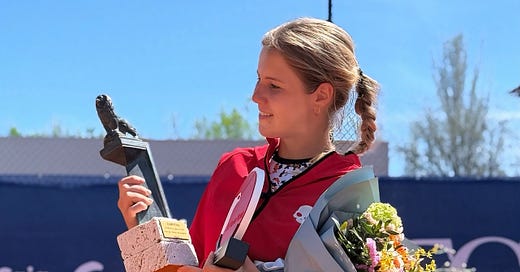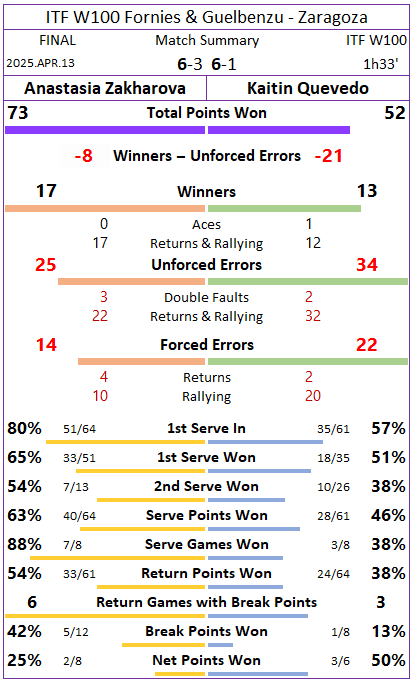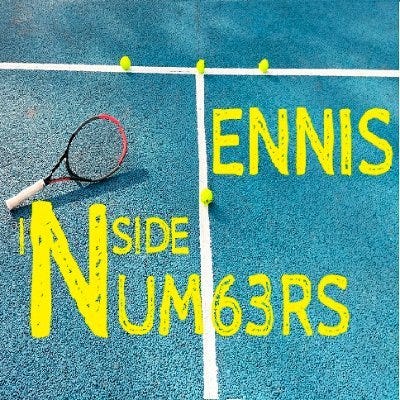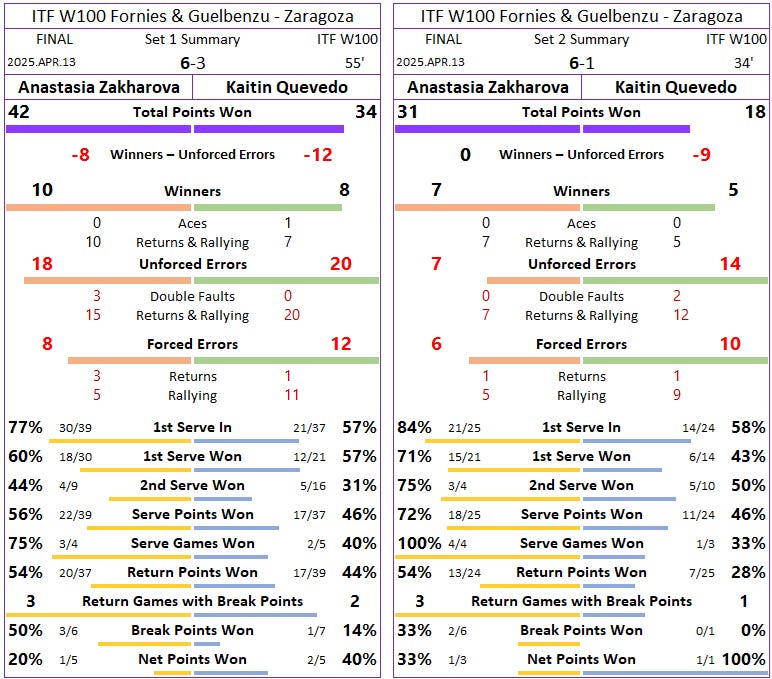ITF W100 Zaragoza: Anastasia Zakharova vs Kaitlin Quevedo final analysis
Zakharova's ITF Tour streak reaches 15 matches
Close but yet to crack the Top-100, Anastasia Zakharova (WTA #128) splits her schedule between the ITF Tour and (qualies of) WTA Tour events.
Away from the ITF Tour for nearly 6 months — since claiming back-to-back titles at W50 Cherbourg-en-Cotentin and W100 Les Franqueses del Valles in October — Zakharova returned last week to the secondary circuit with another title, this time at W100 Zaragoza. A triumph sealed with a 6-3, 6-1 win over wild card Kaitlin Quevedo (WTA #334) in the championship match and that gave Zakharova her first trophy on clay since 2019.
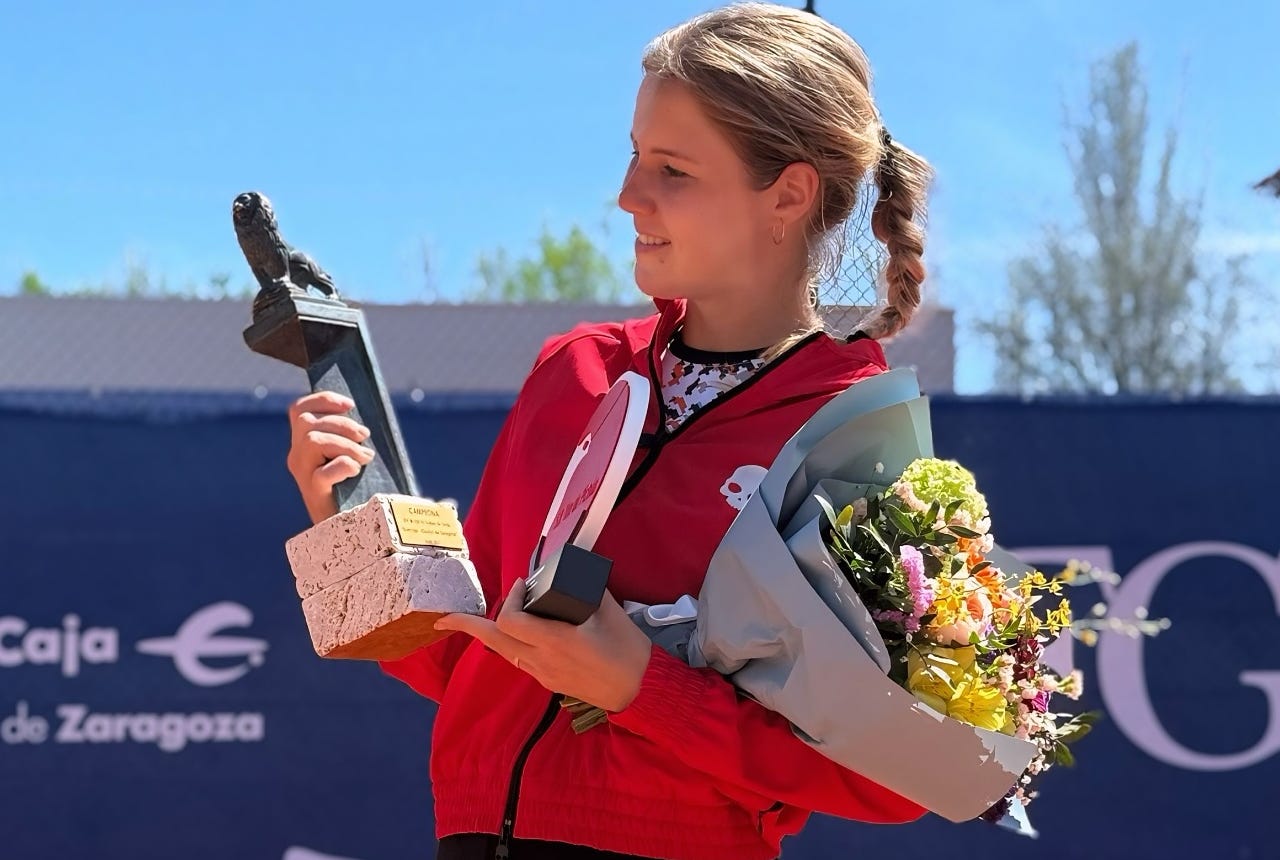
For several years, Zakharova’s ITF Tour success was restricted to the lowest levels, namely ITF W35s or below. It all changed last July when the 23-year old Russian got hot at W100 Figueira da Foz, not dropping a set all week en route to victory in one of a relatively small number of tournaments that hold the highest ITF Tour classification.
Since then, Zakharova has been on a tear whenever she drops down to the secondary circuit, winning 26 of 29 matches for 5 finals and 4 titles — 3 at W100s — in 7 events entered.
Zakharova on the ITF Tour since July 2024
26-3 match record, currently on a 15-0 run
5 finals reached in 7 events played
4 titles: W100 Figueira da Foz, W50 Cherbourg-en-Cotentin, W100 Les Franqueses del Valles, W100 Zaragoza
Superb achievements and stats that contrast with Zakharova’s 11-15 record at WTA Tour or WTA 125 tournaments since her July 2024 breakthrough, with only 4 of those wins happening in main draw matches. So that’s where she will need to improve in the near future to take the next step.
Match analysis
The ITF W100 Zaragoza final was decided by:
Long rallies
Baseline duels
Backhand performances
All of these differences resulted from Zakharova’s superior court position and ability to take control of points with aggressive, early-rally shots.
📺 source: Marca
Always very close to the baseline and eager to hit on the rise, Zakharova used fast, flat and deep shots to deny Quevedo time, push her back or make her move.
The 19-year old Spaniard scrambled to keep points alive but collected very little out of it. Rarely was she able to turn points around and Zakharova didn’t waste much once in command.
Extending rallies to temporarily delay the inevitable was the best Quevedo got for her efforts. This pushed a number of points towards the long range category, which in turn created a huge gap in that metric.
1. Long rallies
Out of 24 points that reached a 9th shot, Zakharova won 18.
That’s 75% of long rallies won by the Russian, for a 12-point advantage (18 to 6). A decisive interval that provided as much as 57% of the final winning margin.
The Zaragoza final was a great example of a player (Zakharova) seeking control woith first-strike tennis but then finding the right amount of patience and a remarkable balance between consistency without sacrificing the ability to dictate and aggression without making too many errors when dragged into longer exchanges.
2. Baseline duels
Both finalists spent most of the match at the back of the court. Considering that fact and how Zakharova dominated all rally length intervals (see table above), her colossal 24-point edge in baseline duels (59 to 35) wasn’t particularly shocking.
3. Backhand performances
From start to finish, it was frequent to watch Zakharova come out on top of backhand exchanges that developed through the AD court.
Overall, contrasting backhand performances created a massive 28-point gap.
While Zakharova struck 21 winning backhands with just 17 errors for a +4 differential, Quevedo only managed to hit 11 winning backhands with 35 errors from that wing for a -24 differential.
Zakharova’s backhand performance
+4 = 6 winners + 15 forcing shots / 17 errors
Quevedo’s backhand performance
-24 = 4 winners + 7 forcing shots / 35 errors

The opposite was observed for forehand performances, with final numbers a lot closer.
Both players accumulated 19 errors from that side and the small differences originated from winning shots: Zakharova hit 3 more forehand winners and an extra pair of forceful forehands.
Zakharova’s forehand performance
-3 = 11 winners + 5 forcing shots / 19 errors
Quevedo’s forehand performance
-8 = 8 winners + 3 forcing shots / 19 errors

These numbers certainly suggest Quevedo played a bit too much to Zakharova’s backhand and should have been more active in shifting rallies towards forehands/Deuce side.
However, given the amount of shots Quevedo hit off-balance, on the move or without much time, it is difficult to assess if she was unaware of that strategic need, unable to try it or just unsuccessful executing it.
Anastasia Zakharova (WTA #128, seed 6) vs Kaitlin Quevedo (WTA #334, wild card)
2025 Zaragoza final - Match Data
Set by Set Stats
Strokes Breakdown

Winners and Errors (returns and rally shots)
Direction of winning shots and unforced errors (only groundstrokes)

Serve and Return
1st Serves
2nd Serves
Return & rallying performance

Rally length
Points won breakdown
This final section gives a last, broader look at the match by presenting how each player won points. Points are listed according to their frequency (highest to lowest) and are named in relation to the last touch on the ball. For simplicity, groundstrokes hit from the 5th shot onwards are grouped together.
Breakdown by side (FHs or BHs)

Breakdown by error type (UFEs or FEs)

To find out more about the stats published here, please visit the following post.
While we follow the same criteria used on all major tennis events, our stats are collected through our own video analysis and are not official WTA or ITF stats.
Thanks for reading!
— Tennis Inside Numbers

